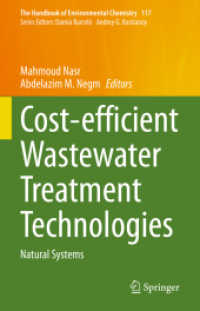- ホーム
- > 洋書
- > 英文書
- > Computer / General
Full Description
From theory to techniques, the first all-in-one resource for EIS
There is a clear demand in advanced process industries, defense, and Internet and communication (VoIP) applications for intelligent yet adaptive/evolving systems. Evolving Intelligent Systems is the first self- contained volume that covers this newly established concept in its entirety, from a systematic methodology to case studies to industrial applications. Featuring chapters written by leading world experts, it addresses the progress, trends, and major achievements in this emerging research field, with a strong emphasis on the balance between novel theoretical results and solutions and practical real-life applications.
Explains the following fundamental approaches for developing evolving intelligent systems (EIS):
the Hierarchical Prioritized Structure
the Participatory Learning Paradigm
the Evolving Takagi-Sugeno fuzzy systems (eTS+)
the evolving clustering algorithm that stems from the well-known Gustafson-Kessel offline clustering algorithm
Emphasizes the importance and increased interest in online processing of data streams
Outlines the general strategy of using the fuzzy dynamic clustering as a foundation for evolvable information granulation
Presents a methodology for developing robust and interpretable evolving fuzzy rule-based systems
Introduces an integrated approach to incremental (real-time) feature extraction and classification
Proposes a study on the stability of evolving neuro-fuzzy recurrent networks
Details methodologies for evolving clustering and classification
Reveals different applications of EIS to address real problems in areas of:
evolving inferential sensors in chemical and petrochemical industry
learning and recognition in robotics
Features downloadable software resources
Evolving Intelligent Systems is the one-stop reference guide for both theoretical and practical issues for computer scientists, engineers, researchers, applied mathematicians, machine learning and data mining experts, graduate students, and professionals.
Contents
PREFACE. Evolving Intelligent Systems.
The Editors.
PART I: METHODOLOGY.
Evolving Fuzzy Systems.
1. Learning Methods for Evolving Intelligent Systems (R. Yager).
2. Evolving Takagi-Sugeno Fuzzy Systems from Data Streams (eTS+) (P. Angelov).
3. Fuzzy Models of Evolvable Granularity (W. Pedrycz).
4. Evolving Fuzzy Modeling Using Participatory Learning (E. Lima, M. Hell, R. Ballini, and F. Gomide).
5. Towards Robust and Transparent Evolving Fuzzy Systems (E. Lughofer).
6. The building of fuzzy systems in real-time: towards interpretable fuzzy rules (A. Dourado, C. Pereira, and V. Ramos).
Evolving Neuro-Fuzzy Systems.
7. On-line Feature Selection for Evolving Intelligent Systems (S. Ozawa, S. Pang, and N. Kasabov).
8. Stability Analysis of an On-Line Evolving Neuro-Fuzzy Network (J. de J. Rubio Avila).
9. On-line Identification of Self-organizing Fuzzy Neural Networks for Modelling Time-varying Complex Systems (G. Prasad, T. M. McGinnity, and G. Leng).
10. Data Fusion via Fission for the Analysis of Brain Death (L. Li, Y. Saito, D. Looney, T. Tanaka, J. Cao, and D. Mandic).
Evolving Fuzzy Clustering and Classification.
11. Similarity Analysis and Knowledge Acquisition by Use of Evolving Neural Models and Fuzzy Decision (G. Vachkov).
12. An Extended version of Gustafson-Kessel Clustering Algorithm for Evolving Data Stream Clustering (D. Filev, and O. Georgieva).
13. Evolving Fuzzy Classification of Non-Stationary Time Series (Y. Bodyanskiy, Y. Gorshkov, I. Kokshenev, and V. Kolodyazhniy).
PART II: APPLICATIONS OF EIS.
14. Evolving Intelligent Sensors in Chemical Industry (A. Kordon et al.).
15. Recognition of Human Grasps by Fuzzy Modeling (R Palm, B Kadmiry, and B Iliev).
16. Evolutionary Architecture for Lifelong Learning and Real-time Operation in Autonomous Robots (R. J. Duro, F. Bellas and J.A. Becerra) 17. Applications of Evolving Intelligent Systems to Oil and Gas Industry (J. J. Macias Hernandez et al.).
Conclusion.








